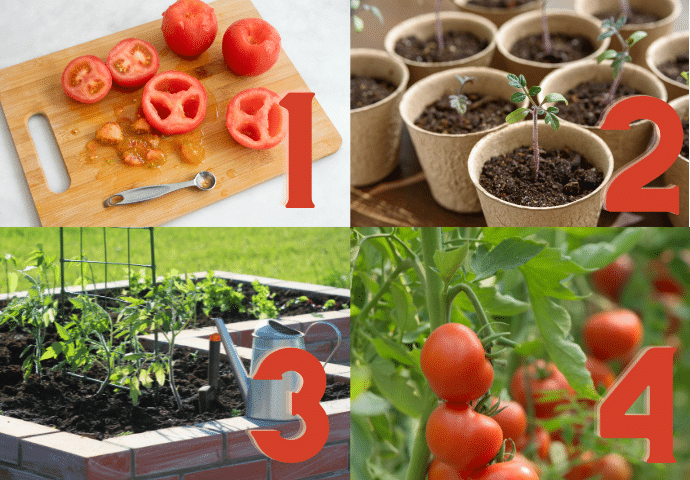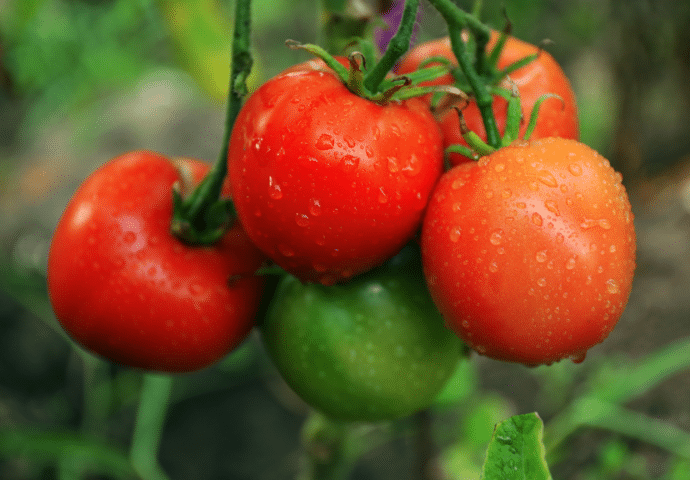If you’re looking for a delicious and nutritious way to use up your leftover tomatoes, why not try growing them at home?
Growing tomatoes at home has many benefits, including the nutritional value of the tomatoes, the cost-effectiveness of growing your own tomatoes, and the convenience of being able to grow them right in your own backyard. Plus, it’s a fun and easy project that the whole family can enjoy! Here are some tips on how to grow tomatoes at home from leftover tomatoes:
Where is the best place to get tomato seeds?
Perhaps the easiest method to obtain tomato seeds, but certainly not the safest, is by separating and drying tomato seeds purchased at the supermarket. It is imperative to consider the seed from which that tomato germinated. There is no guarantee that the seed will grow tomatoes.
If you still want to try: cut a ripe tomato from the supermarket in half and sprinkle its seeds over the mesh. Wash the seeds from the rest of the tomato, and spread them on absorbent paper so that they are completely covered.
Tomato seeds from the nurseries
Although there are thousands of different varieties of tomatoes, most of the tomato bouquets in the standard nurseries will only be of accepted and approved varieties for cultivation in the Land of Israel, such as the cherry tomato varieties, Hamoni Maker (regila), the date (ellipsis), etc.
It is recommended to purchase heirloom seeds, professional breeding seeds or open pollinated varieties when purchasing tomato seeds, as they are seeds for years to come.

Here are the steps for growing tomatoes
1. Choose the right containers. Tomatoes can be grown in a variety of containers, including plastic pots, wooden boxes, or even old tires. Just make sure that the container has drainage holes in the bottom so that excess water can escape.
2. Prepare the soil. Tomatoes need well-drained, nutrient-rich soil in order to thrive. If you’re using potting mix, be sure to add some compost or manure to it before planting your tomatoes.
3. Plant the tomatoes. When planting your tomatoes, be sure to bury them deep enough so that only the top few leaves are above ground level. This will help them develop strong roots systems.
4. Water the tomatoes regularly. Tomatoes need about an inch of water per week, so be sure to water them deeply and evenly every week during the growing season.
5. Fertilize the tomatoes monthly. A simple fertilizer like fish emulsion or compost tea will do
Why Growing Tomatoes at Home is Beneficial.
Tomatoes are an excellent source of several vitamins and minerals, including vitamin C, potassium, and folate. They also contain lycopene, a powerful antioxidant that has been linked to a reduced risk of heart disease and some types of cancer.
The Cost-Effectiveness of Growing Tomatoes at Home.
Growing tomatoes at home can save you money compared to buying them at the store. You can control the cost of inputs like soil and fertilizer, and you don’t have to worry about shipping or other charges. Plus, you can grow as many (or as few) tomatoes as you want, so there’s no waste.
The Convenience of Growing Tomatoes at Home.
Fresh tomatoes are always just a few steps away when you grow them at home. You can pick them right off the vine and enjoy them in salads, sandwiches, sauces, or just by themselves. There’s nothing quite like the taste of a freshly picked tomato!
Steps to Growing Tomatoes at Home from Leftover Tomatoes.
The first step to growing tomatoes at home from leftover tomatoes is to choose the right containers. Tomatoes can be grown in a variety of containers, but it is important to choose ones that are deep enough and have drainage holes. Some good options for containers include plastic pots, buckets, barrels, or grow bags.
Prepare the Soil.
Once you have chosen the right containers, the next step is to prepare the soil. Tomatoes need well-drained, sandy loam soil with a pH of 6.0-7.0. If you are not sure about the quality of your soil, you can get it tested by your local Cooperative Extension Service. To improve drainage, mix in some organic matter such as compost or peat moss.
Plant the Tomatoes.
Now it’s time to plant the tomatoes! When planting tomatoes in containers, it is best to use determinate varieties that will stay compact and not require staking. Indeterminate varieties can also be grown in containers, but they will need support such as cages or trellises. tomato plants should be planted 18-24 inches apart so they have room to grow.
Water the Tomatoes.
Tomatoes need a lot of water, so it is important to keep them evenly watered throughout the growing season. Water at the base of the plant rather than overhead to avoid getting water on the leaves which can lead to fungal diseases. Aim for 1-2 inches of water per week, and more during hot weather or if your plants are wilting due to lack of water.
Fertilize the Tomatoes.
Tomatoes are heavy feeders and will benefit from regular fertilization. Use a balanced fertilizer such as 10-10-10 or 12-12-12 at the rate of 1 pound per 100 square feet of garden area. Apply fertilizer when plants are first getting established, then every 4-6 weeks during the growing season. Avoid getting fertilizer on the leaves to prevent leaf burn.
Following these steps should result in a bountiful harvest of delicious tomatoes that can be used in a variety of recipes or simply enjoyed fresh off the vine!

Conclusion
Growing tomatoes at home from leftover tomatoes is a great way to get the most out of your tomato plants. Not only are tomatoes highly nutritious, but growing them at home can also save you money and be more convenient than buying them from the store.
To grow tomatoes at home from leftover tomatoes, start by choosing the right containers. Next, prepare the soil and plant the tomatoes. Be sure to water them regularly and fertilize them as needed. With a little care and attention, you can enjoy fresh, homegrown tomatoes all season long!
There are many vegetables that can be grown at home from leftovers, such as avocados, green onions, cauliflower. For the full list click here


